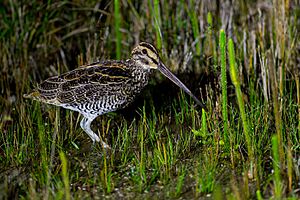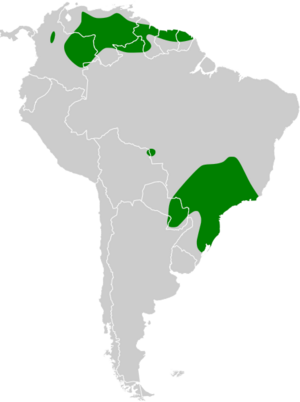Giant snipe facts for kids
Quick facts for kids Giant snipe |
|
|---|---|
 |
|
| Conservation status | |
| Scientific classification | |
 |
The giant snipe (Gallinago undulata) is a large bird that loves wet places. It's a type of wader, which means it spends its time in shallow water or muddy areas. These birds live and have their babies in South America.
You can find them in two main areas. One group lives in Colombia. The other group stretches from Venezuela through Guyana, Suriname, and French Guiana all the way to the very north-east of Brazil. There's also a southern group found in eastern Bolivia, eastern Paraguay, and south-east Brazil. They might also be in Uruguay and north-eastern Argentina.
Giant snipes like to live in tall plants found in swamps and flooded grasslands. Sometimes, you might even spot them in dry grassy areas. They can live from lowlands up to high places, about 2,200 meters (that's over 7,200 feet) above sea level! We don't know much about where they go during different seasons. They seem to show up in some places after it rains a lot.
What's in a Name?
Scientists give every living thing a special two-part name. For the giant snipe, its scientific name is Gallinago undulata. This helps scientists all over the world know exactly which bird they are talking about.
There are two main types, or subspecies, of giant snipe:
- G. u. undulata: This type lives in Colombia, Venezuela, the Guianas, and northern Brazil.
- G. u. gigantea: This type is found from eastern Bolivia to Paraguay, southeast Brazil, and northeast Argentina.
Meet the Giant Snipe
The giant snipe is the biggest of all the snipes! It can be from 36 to 47 centimeters (about 14 to 18.5 inches) long. The G. u. gigantea subspecies is even bigger than the other one. Its beak alone can be longer than 12 centimeters (almost 5 inches)! These birds can weigh between 270 and 500 grams (about 9.5 to 17.6 ounces).
This bird has a strong body and legs that are quite short for a wader. Its wings are wide and rounded, a bit like a woodcock. It also has a very long, straight beak that looks like a horn.
Its back, head, and neck are covered in stripes and patterns of black and brown. Some feathers have chestnut-colored edges that create clear lines down its back. Its belly is white, and its sides have brown stripes. A cool thing about this snipe is that its flight feathers have stripes, which is special among snipes. Its legs and feet are a greenish-grey color.
Male and female giant snipes look the same. Young birds also look very similar to adults.
When a giant snipe is startled and flies away, it makes a "kek-kek" sound. During its special night-time flight display, it makes a rough, three-part call.
You can tell a giant snipe apart from other snipes by its huge size and rounded wings. Other large snipes live in mountains and don't have the clear patterns on their backs or the white belly that the giant snipe has.
Life and Habits
Giant snipes are very shy birds, so it's hard to study them! They are rarely seen on the ground. They also have amazing camouflage, which means their feathers help them blend in perfectly with their surroundings. They also prefer to feed at night. All these things make them super secretive.
Nests of the southern giant snipe have been found in Brazil between September and early January. They build their nests on small hills between swamps. A mother snipe usually lays 2 to 4 eggs. We haven't found any nests of the northern giant snipe yet.
Their diet seems to include small creatures like frogs. When you do see a giant snipe, it's usually by itself.
Other types of snipes perform a special air show. They fly high in circles, then dive down fast. As they dive, their special outer tail feathers vibrate, making a "drumming" sound. The giant snipe also does a display flight at night, but we don't know if it makes the drumming sound.
Is the Giant Snipe Safe?
People hunt the giant snipe in many places because its large size makes it an easier target than other snipes. Losing their natural homes, or habitat loss, is also a problem for them.
The giant snipe is not a common bird anywhere. It's rare in places like Colombia and Venezuela. However, because it's so good at hiding and is active at night, it might seem rarer than it actually is. For now, scientists don't think it's in danger of disappearing. Its conservation status is "Least Concern," which means it's not currently threatened.


